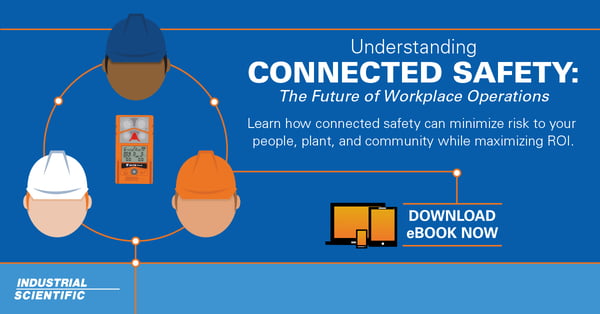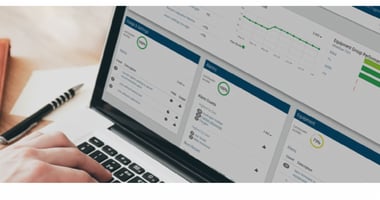For decades, industrial environments relied on “islands of safety” to protect workers. Gas detection, personal protective equipment (PPE), fall protection, and other aspects of safety were all standalone solutions that never truly worked together.
However, technological advancements have made it not only possible, but also easy to bring these islands together and create safer environments for employees through what’s known as connected safety.
Gas detectors and PPE can help protect individuals, but connected safety promises more by giving you actionable insights on your safety program. Though we’re not able to completely eliminate hazards, connected safety technologies enable you to monitor worker safety and entire worksites in real time, giving you instant visibility into hazards that can injure employees and hurt the bottom line.
Just like with gas detection, connected safety solutions differ from application to application. Whether you’re building a connected safety solution for confined space monitoring, fire and emergency response, or any other application, you need the right equipment for the job.
How do you integrate gas detection into the world of big data and sensors? Let’s consider the pieces of a connected safety program.
Components of a Connected Safety Program
Connected safety solutions became a reality thanks to Internet of Things (IoT) technology, which empowers businesses to build data-sharing infrastructure. This infrastructure creates a world of devices and analytics that enable data-driven decisions to protect not just individual workers, but entire teams, facilities, and communities.
These platforms consist of three distinct components:
1. Hardware and Equipment
Every connected safety program starts with reliable hardware, in this case, gas detectors. Without the proper hardware and equipment in place, connected safety falls apart.
These connected devices not only monitor workers, but also monitor the environment around them to collect valuable data and insights in real time. Depending on the environment, the hardware portion of a connected safety solution might include personal gas detectors, area monitors, or some combination of the two.
It’s no longer enough to have gas detectors alone. Personal gas detectors must also share alarms and gas readings with nearby monitors and transmit real-time location and other valuable data to enable teams to stay in contact.
When it comes to an area monitor, a good connected safety program should include a connected monitor that can share information with portable gas detectors to create a safety network between workers.
2. Connectivity
To maximize the effectiveness of a connected safety program, you’ll need to consider your connectivity method. Consider wi-fi, cellular, satellite, and peer-to-peer networks and determine what solution fits your application and infrastructure.
Peer-to-peer networks, also known as mesh networks, are becoming a popular choice for industrial environments due to their reliability and minimal IT setup. Mesh networks, like LENS® Wireless, use devices as nodes to transmit data to ensure a fast and simple flow of information. They are also self-healing, meaning they can still function and transmit information even if one or more devices disconnect from the network. Peer-to-peer connectivity is a great option for local alarm sharing among workers and connected devices.
Wi-fi, cellular, and satellite come into play when you want to transmit information from gas detectors on site to live monitoring software. The connectivity option that’s right for you depends on where and how you’ll use the gas monitors. Wi-fi connectivity is often a good option for in-plant monitoring, while a combination of cellular and satellite is ideal for connecting lone workers in remote locations. Cellular is ideal for a number of different applications, depending on cellular coverage on your site.
3. Management Software
The first two components of a connected safety program ensure workers and teams have awareness of gas hazards around them and are connected to other workers, but management software takes a connected safety program to the next level. Gas detection management software gives you unparalleled visibility into worker safety and leads to actionable insights based on the data collected by gas detectors.
Safety managers are all too familiar with time-consuming tasks like tracking regulatory compliance, identifying hazards workers are exposed to, and gathering historical data when incidents occur. Management software, like iNet® Control, provides an intuitive dashboard you can use to manage workers, equipment, and hazards based on historical data.
Live monitoring software, like iNet® Now, builds on the historical data from iNet Control by adding real-time monitoring. This is one of the most valuable components of a connected safety program. When a hazard occurs, live monitoring software automatically alerts a central contact via text, email, or on-screen alerts with information on the type of alarm, who is in danger, their location, and more. With this type of visibility, you can take appropriate action in seconds instead of waiting for an incident report.
Management software can also alert you if gas detectors are shut off, when a worker has spent too much time in dangerous conditions, and even if instruments are used without being calibrated. All of this information allows you to take ownership of your gas detection program and improve your safety culture.

Connected Safety Applications
When building your connected safety program, make sure it will meet the unique challenges your organization faces. Here are some examples of what a connected safety program could look like:
In Plant
Gas hazards vary across different industries, so your plant's hazards will determine which gases you monitor and how you connect workers. However, it's wise to choose gas detectors for in-plant monitoring that offer a wide range of sensor options, like the Ventis® Pro5 and the Radius® BZ1. These monitors can share data between monitors via a mesh network. Additionally, live monitoring software like iNet Now is beneficial to ensure a supervisor has real-time visibility into all gas hazards throughout the facility.
Confined Space
Personal gas detectors with real-time connectivity are essential for confined space work. Not only do they allow you to sample the atmosphere in a confined space prior to entry, but they also offer real-time data and readings while working. A personal gas detector like the Ventis Pro5 with LENS Wireless peer-to-peer connectivity ensures that attendants outside of the confined space know what's happening inside. This connectivity can even help prevent would-be rescuer tragedies, where a worker attempts to rescue a peer in a confined space, only to be overcome by the same gas hazards. You can also pair these monitors with an RGX Gateway to transmit data to cloud-based iNet Now Live Monitoring software so remote supervisors can monitor entries in real time.
Lone Worker
The best way to ensure the safety of lone workers is to connect them through live monitoring software, like iNet Now. Connected personal gas detectors ensure that you know where workers are located, what gas hazards they are exposed to, and whether they need help. Wireless gateways with cellular and satellite connectivity are great options for transmitting real-time readings, no matter how remote the location.
Hot Work
Portable gas detectors are required for the pre-work hazard assessment for any hot work in confined spaces. While hot work is being performed, personal and area monitors must be used to continuously monitor the area.
An area monitor, like the Radius® BZ1, might be placed upwind of a hot work site to provide an early warning of dangerous conditions, and LENS Wireless connectivity can alert nearby workers if any hazards come their way.
Hazmat
When responders arrive at a hazmat scene, they often don't know whether the area contains deadly or harmful chemicals. Personal gas monitors, like the Ventis Pro5, help responders test for deadly hazards in the atmosphere. These wireless monitors allow responders to share readings with peers on site, so everyone has full visibility into what’s happening to their peers nearby. This connectivity can also extend to area monitors used to establish a perimeter for the hazard in case it begins to migrate. Beyond monitoring conditions on site, it’s helpful to have a “bird’s eye view” of the hazards through live monitoring software like iNet Now or dynamic plume modeling software like SAFER One™.
Fire and Emergency Response
First responders use gas detectors to monitor levels of carbon monoxide, hydrogen cyanide, oxygen, hydrogen sulfide, and the lower explosive limits of gases. However, gas levels can vary widely at the site of a fire or other emergency site, making it critical that workers are aware of the hazards their peers face. With alarm sharing and panic and man-down alarms on the Ventis Pro5, first responders will always know when one of their own needs help.
Fence Line and Perimeter Monitoring
When creating a detection barrier around a hazardous location or around your site to ensure hazards don’t impact neighboring areas, portable and area gas monitors connected by a wireless mesh network offer a convenient way to monitor the area remotely. The connectivity allows workers to view readings from area monitors on their own personal monitors. If necessary, an RGX Gateway can be used to transmit real-time information to the cloud so a supervisor is always up to date on site conditions. Dynamic plume modeling software can then use the real-time data from on-site gas sensors and pair it with weather data to predict the path and impacted areas should a gas hazard begin to move outside of the perimeter.
Turnarounds and Shutdowns
Turnaround and shutdown leaders commonly rent equipment, like gas detectors, docking stations, and even software to temporarily modify their gas detection programs to fit the circumstances. These situations tend to be hectic, so iNet® Now Live Monitoring is ideal for providing real-time visibility into alarm events and gas exposures. This visibility helps you track additional workers to ensure everyone from contractors to seasoned workers follow safety protocols.
To learn more about connected safety solutions for your gas detection program, download this guide.



